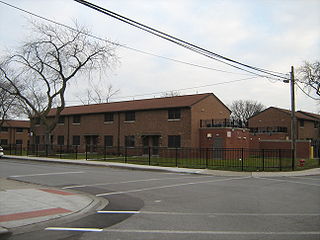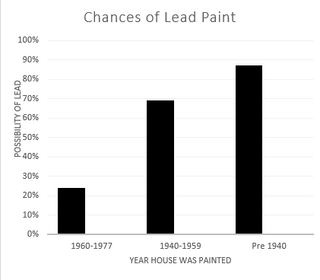Related Research Articles

Isocyanate is the functional group with the formula R−N=C=O. Organic compounds that contain an isocyanate group are referred to as isocyanates. An organic compound with two isocyanate groups is known as a diisocyanate. Diisocyanates are manufactured for the production of polyurethanes, a class of polymers.

Lead poisoning, also known as plumbism and saturnism, is a type of metal poisoning caused by lead in the body. The brain is the most sensitive. Symptoms may include abdominal pain, constipation, headaches, irritability, memory problems, infertility, and tingling in the hands and feet. It causes almost 10% of intellectual disability of otherwise unknown cause and can result in behavioral problems. Some of the effects are permanent. In severe cases, anemia, seizures, coma, or death may occur.
A blood-borne disease is a disease that can be spread through contamination by blood and other body fluids. Blood can contain pathogens of various types, chief among which are microorganisms, like bacteria and parasites, and non-living infectious agents such as viruses. Three bloodborne pathogens in particular, all viruses, are cited as of primary concern to health workers by the CDC-NIOSH: HIV, hepatitis B (HVB), & hepatitis C (HVC).

Occupational hygiene is the anticipation, recognition, evaluation, control, and confirmation of protection from hazards at work that may result in injury, illness, or affect the well being of workers. These hazards or stressors are typically divided into the categories biological, chemical, physical, ergonomic and psychosocial. The risk of a health effect from a given stressor is a function of the hazard multiplied by the exposure to the individual or group. For chemicals, the hazard can be understood by the dose response profile most often based on toxicological studies or models. Occupational hygienists work closely with toxicologists for understanding chemical hazards, physicists for physical hazards, and physicians and microbiologists for biological hazards Environmental and occupational hygienists are considered experts in exposure science and exposure risk management. Depending on an individual's type of job, a hygienist will apply their exposure science expertise for the protection of workers, consumers and/or communities.

A chemical hazard is a (non-biological) substance that has the potential to cause harm to life or health. Chemicals are widely used in the home and in many other places. Exposure to chemicals can cause acute or long-term detrimental health effects. There are many types of hazardous chemicals, including neurotoxins, immune agents, dermatologic agents, carcinogens, reproductive toxins, systemic toxins, asthmagens, pneumoconiotic agents, and sensitizers. In the workplace, exposure to chemical hazards is a type of occupational hazard. The use of protective personal equipment(PPE) may substantially reduce the risk of damage from contact with hazardous materials.

Lead paint or lead-based paint is paint containing lead. As pigment, lead(II) chromate (PbCrO4, "chrome yellow"), Lead(II,IV) oxide, (Pb3O4, "red lead"), and lead(II) carbonate (PbCO3, "white lead") are the most common forms. Lead is added to paint to accelerate drying, increase durability, maintain a fresh appearance, and resist moisture that causes corrosion. It is one of the main health and environmental hazards associated with paint. Alternatives such as water-based, lead-free traffic paint are readily available, and many states and federal agencies have changed their purchasing contracts to buy these instead.

Herbert Leroy Needleman researched the neurodevelopmental damage caused by lead poisoning. He was a pediatrician, child psychiatrist, researcher and professor at the University of Pittsburgh, an elected member of the Institute of Medicine, and the founder of the Alliance to End Childhood Lead Poisoning. Dr. Needleman played a key role in securing some of the most significant environmental health protections achieved during the 20th century, which resulted in a fivefold reduction in the prevalence of lead poisoning among children in the United States by the early 1990s. Despite engendering strong resistance from lead-related industries, which made him the target of frequent attacks, Needleman persisted in campaigning to educate stakeholders, including parents and government panels, about the dangers of lead poisoning. Needleman has been credited with having played a key role in triggering environmental safety measures that have reduced average blood lead levels by an estimated 78 percent between 1976 and 1991. He died in Pittsburgh in 2017.

Altgeld Gardens Homes is a Chicago Housing Authority (CHA) public housing project located on the far south side of Chicago, Illinois, United States. It sits on the border of Chicago and Riverdale, Illinois. The residents are 97% African-American according to the 2000 United States Census. Built between 1944 and 1945 with 1,498 units, the development consists primarily of two-story row houses spread over 190 acres (0.77 km2).

Mold or mould, also sometimes referred to as mildew, is a fungal growth that develops on wet materials. Mold is a natural part of the environment and plays an important part in nature by breaking down dead organic matter such as fallen leaves and dead trees; indoors, mold growth should be avoided. Mold reproduce by means of tiny spores. The spores are like seeds, but invisible to the naked eye, that float through the air and deposit on surfaces. When the temperature, moisture, and available nutrient conditions are correct, the spores can form into new mold colonies where they are deposited. There are many types of mold, but all require moisture and a food source for growth.
The National Center for Healthy Housing (NCHH) is a national nonprofit dedicated to creating safe and healthy housing for America’s families. Its research often provides scientific basis for federal, state, and local policies and programs. NCHH trained nearly 45,000 individuals in healthy housing practices from 2005 through 2014. NCHH's advocacy efforts aim to ensure that health is considered in housing policy and that housing is valued as a determinant of health. Through partnerships, NCHH seeks to reduce health disparities in low-income communities and communities of color. Founded by Fannie Mae in 1992, it was originally known as the National Center for Lead-Safe Housing. NCHH's main office is based in downtown Columbia, Maryland.
Workplace health surveillance or occupational health surveillance (U.S.) is the ongoing systematic collection, analysis, and dissemination of exposure and health data on groups of workers. The Joint ILO/WHO Committee on Occupational Health at its 12th Session in 1995 defined an occupational health surveillance system as “a system which includes a functional capacity for data collection, analysis and dissemination linked to occupational health programmes”.

Lead-based paint was widely used in the United States, because of its durability. The United States banned the manufacture of lead-based house paint in 1978 due to health concerns.

The Kenosha/Racine Lead-Free Communities Partnership is a joint venture of Kenosha County, Wisconsin and the city of Racine, Wisconsin, along with various community organizations. It began in March 2007 as a three-year program with a goal of making 320 homes in Racine and Kenosha lead-safe. Its overall aim is to educate the public about the dangers of lead poisoning and to help low-income families with small children improve their living conditions by replacing and/or repairing the largest sources of lead in their home. As of July 9, 2009, 433 living units had been assessed and the program had cleared 321 homes of lead hazards.

The ECO Funnel, also known as the "Safety Ecological Funnel", is a funnel intended to be affixed to a receptacle for liquid chemical waste. It is designed to reduce environmental contamination, in compliance with OSHA and EPA mandated safety protocols.
Lead contamination in Oakland represents a serious and persistent public health threat. Lead contamination in modern Oakland comes from three primary sources: remnants from previous industry, deposits from leaded gasoline, and paint chips from leaded paints. Significant portions of the City of Oakland, California have soil lead levels far in excess of 400 ppm, the level at which the US EPA suggests remedial action be taken, and far higher than 80 ppm, the level at which California’s Office of Environmental Health Hazard Assessment suggests action should be taken. Not all areas of Oakland are affected equally: West Oakland's contamination is especially severe, particularly near the former Oakland Army Base, and many of Oakland's poorer neighborhoods also suffer disproportionately.

Agricultural safety and health is an aspect of occupational safety and health in the agricultural workplace. It specifically addresses the health and safety of farmers, farm workers, and their families.

Lead abatement includes lead-based paint abatement activities, such as inspections, risk assessments, and removal, that must be performed by educated, certified professionals and are aimed to permanently eliminate lead-based paint hazards, such as serious permanent and irreversible health damage due to lead poisoning in children, from the home environment and any facility with frequent visitation by children, particularly those built before 1978.

Lead abatement is an activity to reduce levels of lead, particularly in the home environment, generally to permanently eliminate lead-based paint hazards, in order to reduce or eliminate incidents of lead poisoning.
The Baltimore Lead Paint Study was a controversial clinical study conducted by the Johns Hopkins Kennedy Krieger Institute (KKI) in poor Baltimorean neighborhoods during the 1990s. The purpose of the study was to investigate the health effects of lead paint in children and the effectiveness of lower cost techniques in abating lead content in residential properties. Upon discovery of the study, the study ended at the turn of the millennium and met extensive criticism for issues regarding the target population, a significant portion of which were African American children, and patient ethics such as consent regarding children and health risks when exposing subjects to cheaper but less effective health conditions. The backlash culminated in class action lawsuits against KKI by Ericka Grimes and Myron Higgins, two of the subjects representing on the order of a hundred affected children without adequate care.

Hazard controls for COVID-19 in workplaces are the application of occupational safety and health methodologies for hazard controls to the prevention of coronavirus disease 2019 (COVID-19). Vaccination is the most effective way to protect against severe illness or death from COVID-19. Multiple layers of controls are recommended, including measures such as telework and flexible schedules, increased ventilation, personal protective equipment (PPE) and face coverings, physical distancing, and enhanced cleaning programs.
References
- http://www.hcd.ca.gov/fa/home/manual2006/06/D01_Lead-Based_Paint_Chapter.doc Housing and Urban Development - Lead-Based Paint Chapter